Echeveria xochipalensis (Crassulaceae), a new species from Guerrero, Mexico
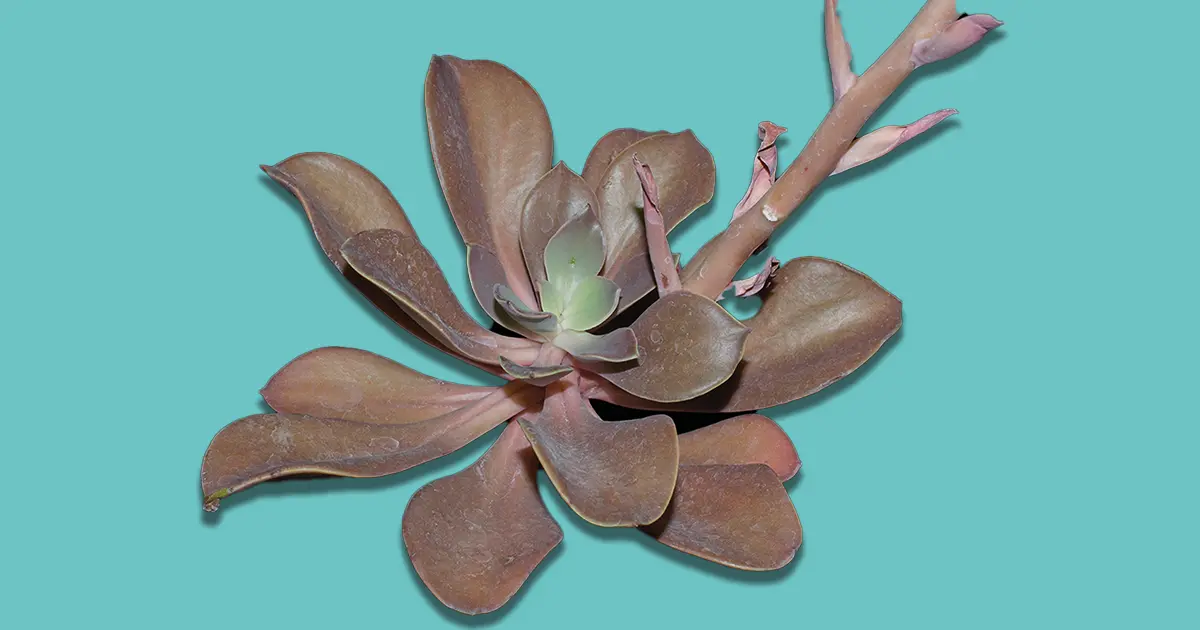
JERÓNIMO REYES SANTIAGO1, LUIS E. DE LA CRUZ-LÓPEZ2,3,* & FRANCISCO VERGARA-SILVA2
1Jardín Botánico, Instituto de Biología, Universidad Nacional Autónoma de México. Circuito exterior s/n, Ciudad Universitaria, Copílco, Coyoacán, C.P. 04510, Ciudad de México, Mexico. email: jreyes@ib.unam.mx
2Laboratorio de Sistemática Molecular, Instituto de Biología, Universidad Nacional Autónoma de México. Circuito exterior s/n, Ciudad Universitaria, Copílco, Coyoacán, C.P. 04510, Ciudad de México, Mexico. email: fvs@ib.unam.mx
3Posgrado en Ciencias Biológicas, Universidad Nacional Autónoma de México, Av. Ciudad Universitaria 3000, C.P. 04360, Coyoacán,
Ciudad de México, Mexico.
*author for correspondence: ledbiologia@hotmail.com
Abstract
Echeveria xochipalensis, from the state of Guerrero, Mexico, is described as a new species to science. It is related to species of ser. Gibbiflorae, particularly to both E. fulgens varieties, from which it is distinguished by its green to lilac-gray spatulate leaves, although they commonly are coppery tinged; the leaves are rigid and with entire margin (not crenate), the margin is yellow-hyaline; bracts oblanceolate with rigid consistency; corolla pink at base and orange at the apex and whitish filaments, ovaries and nectary scales.
Key words: Echeveria, Gibbiflorae, succulents, white leaf scars, Xochipala
Resumen
Se describe e ilustra a Echeveria xochipalensis del estado de Guerrero, México, como nueva especie para la ciencia. Se relaciona con las especies de la ser. Gibbiflorae, en particular con las dos variedades de E. fulgens, de las cuales se diferencia por sus hojas espatuladas de color verde a lila-grisáceas, aunque con frecuencia cobrizas, rígidas y con margen entero (no crenado), éste amarillo-hialino; brácteas oblanceoladas de consistencia rígida; corola de color rosa con ápice naranja y filamentos, ovarios y nectarios blanquecinos.
Introduction
In the genus Echeveria A. P. de Candolle (1828: 401), ser. Gibbiflorae (Baker) A.Berger (1930: 472) consists of approximately 36 described species, and while the limits for the majority of these taxa are more or less evident, E. fulgens Lemaire (1845: 8) shows a great uncertainty in its taxonomic delimitation. This is due to the insufficiency of diagnostic characters in the original description by C. Lemaire and therefore, E. Walther (1972: 159) was forced to redescribe E. fulgens to complete its description, also it lacks a specified type locality. In addition, there is an enormous morphological and morphometric variation found in specimens from different localities in Mexico which have all been associated with this name. Recently, new species in this series have been published which would probably have been associated with E. fulgens, but whose comparison has allowed their differentiation based on morphological diagnostic characters, biogeographical and phenological comparisons among others: E. aurantiaca J.Reyes, O.González & Brachet (Reyes et al. 2011: 70), E. cerrograndensis A.Vázquez & Nieves (Nieves-Hernández et al. 2014: 248), E. munizii Padilla-Lepe & A.Vázquez (Vázquez-García et al. 2014: 166), E. perezcalixii Jimeno-Sevilla & P.Carrillo (Jimeno-Sevilla & Carrillo-Reyes 2010: 303), E. pistioides I.García, I.Torres & Costea (García-Ruiz et al. 2016: 966), E. purhepecha I.García (García-Ruiz 2011: 63) and E. roseiflora J.Reyes & O.González (Reyes & González-Zorzano 2010: 22). From this perspective, the E. fulgens complex has started to break down into smaller and better diagnosable units. Following this trend, E. xochipalensis from specimens collected in the municipality of Eduardo Neri, in the Mexican state of Guerrero, is proposed as a new species to science. The description of the new taxon is based on morphological and geographical evidence.
Material and Methods
Through explorations made to the state of Guerrero, Mexico, during the revision of the genus Echeveria and, in particular, of ser. Gibbiflorae, specimens of this last series were located near the town of La Laguna on the road from Xochipala to Filo de Caballos. Several specimens were collected and deposited in the herbarium MEXU, while others were kept as living plants cultivated in greenhouses of the “Colección Nacional de Crasuláceas”, belonging to the “Instituto de Biología, Universidad Nacional autónoma de México”. Following comparisons with related species (herbarium and cultivated plants), morphological differences between them were identified.
Taxonomic treatment
Echeveria xochipalensis J.Reyes, de la Cruz-López & Vergara-Silva. sp. nov. (FIGS. 1–3)
Echeveria xochipalensis can be distinguished from the E. fulgens complex, by the white leaf scars on the stems, the entire leaf margins, adaxially channeled at the base and pseudo-petiolate, leaf color frequently in hues of copper, the yellowish to hyaline leaf margin, pinkish-orange corolla instead of orange-reddish, the whitish filaments, instead of yellowish in the two E. fulgens varieties, as well as whitish ovaries and nectary scales, instead of yellowish ones (Table 1). It also differs from E. crenulata, by its less branched inflorescences, shorter pedicels and pink-orange (vs pink-yellow) corolla.
Type:—MEXICO, Guerrero, municipality Eduardo Neri, 1960 m, about 2 kms southwest of La Laguna, along the road from Filo de Caballo to Xochipala, 11 November 2012, J. Reyes 8132 (holotype, MEXU!).
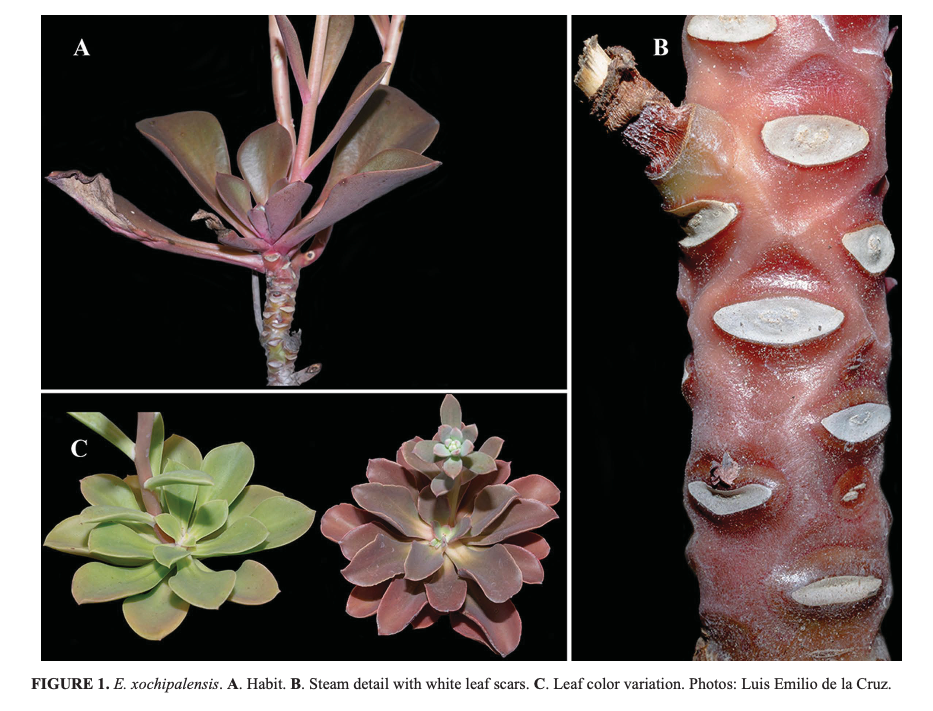
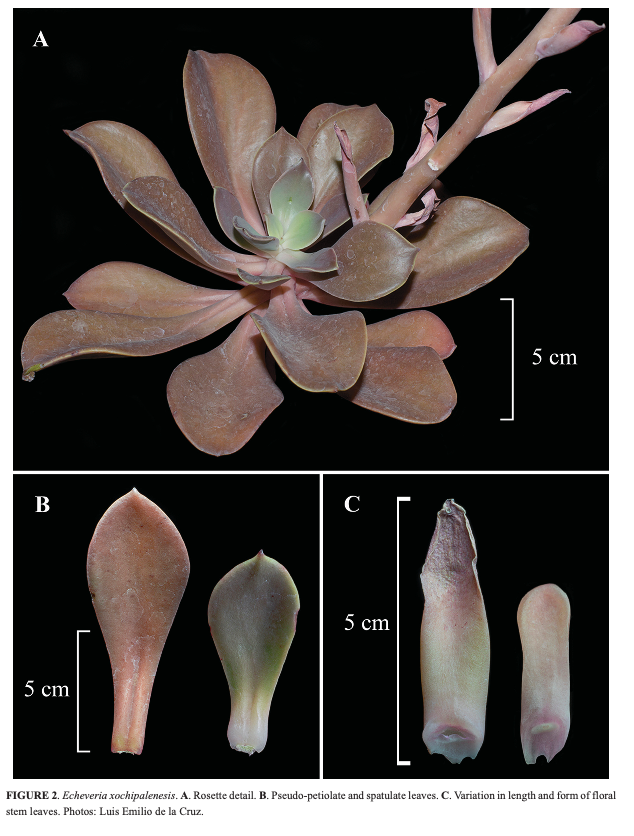
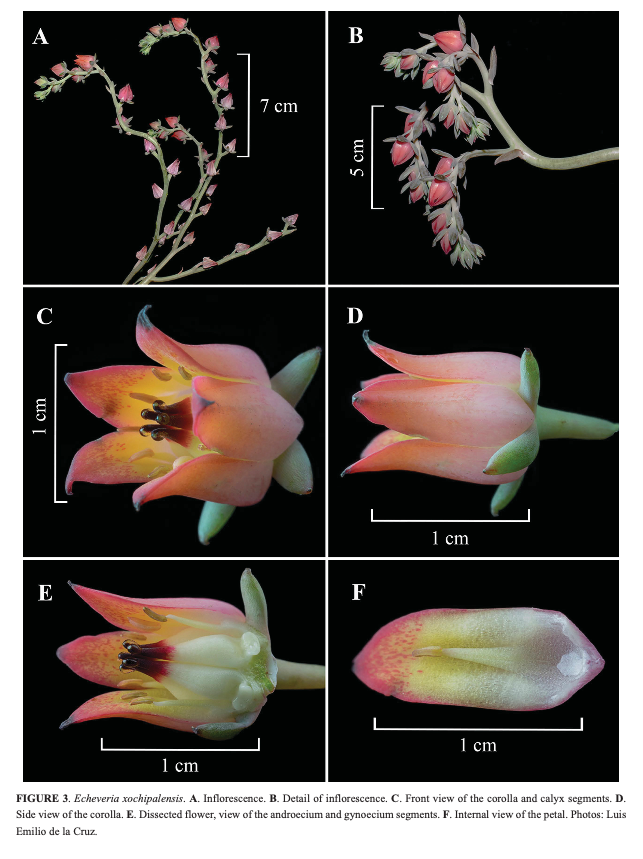
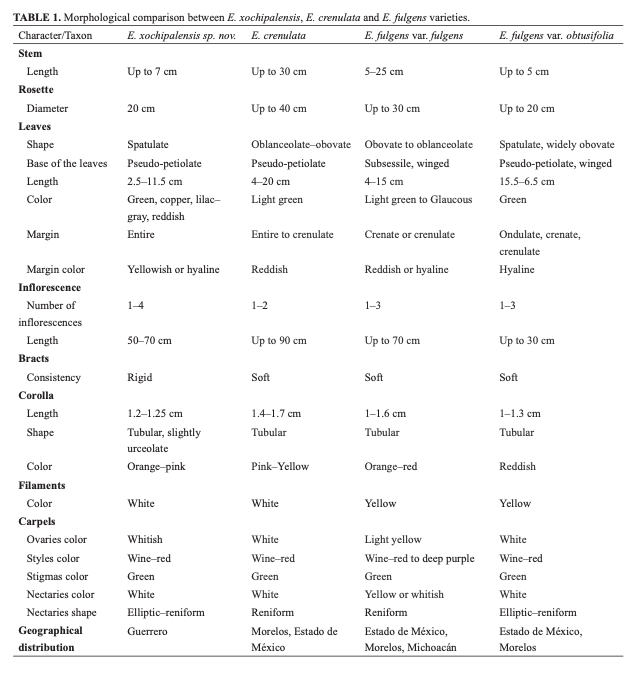
Plant perennial, glabrous, solitary. Main roots somewhat thickened, secondary ones fibrous. Stem erect, simple, up to 7 cm tall, 1–1.3 cm in diameter, brown-reddish at the base and green to pinkish at the apex, with white leaf scars. Rosette lax, up to 20 cm in diameter. Leaves spatulate, pseudo-petiolate, basal leaves green, lilac-gray, or copper colored with pinkish hues, apical leaves greenish, 2.5–11.5 cm long, 1.7–4 cm wide, adaxial surface channeled at base, abaxial surface slightly keeled, only the apical leaves slightly pruinose, apex obtuse to rounded, shortly mucronate, color reddish, margin entire, yellow to hyaline in apical leaves. Floral stem erect, panicle axillary, 1–4 per rosette or more, 50–70 cm long, 1–1.35 cm wide at the base with oblanceolate leaves, quickly deciduous, rigid, ascending, 2–5 cm long, 0.5–0.7 cm wide, spurred, margin entire, apex obtuse, reddish with orange hues. Inflorescence paniculate with up to 4 cincinni of up to 25 cm long, light green, slightly pruinose, bracteoles lanceolate, 0.5–0.7 cm long, 0.17–0.22 cm wide, green to yellowish, spurred, apex acuminate, slightly pruinose. Pedicels 0.5–0.6 cm long, 0.2 cm thick, pale green, slightly pruinose. Calyx 5 sepals, basally fused, deltoid-lanceolate, unequal, 0.5–0.8 cm long, 0.2–0.4 cm wide at the base, 0.2 cm thick, olive green, apex acute, slightly pruinose. Corolla pentagonal in frontal view, slightly urceolate in lateral view, 1.2–1.25 cm long, 0.9–1 cm wide at the base, petals lanceolate, dorsally keeled, united at the base, imbricate, apex acute, slightly deflexed, 0.4 cm wide at the base, pink at the base, orange at the apex, internally tricolored, white at the base, yellow in the middle and reddish at the apex, nectary cavity prominent; androecium shorter than corolla tube, stamens 10, 5 antisepalous, 0.8 cm long, 5 epipetalous, slightly shorter, filaments white with slight yellowish hue, anthers 0.2 cm long, yellow; gynoecium with 5 carpels, free, 0.75–1 cm long, 0.25–0.3 cm wide at the base, nectaries reniform, 0.18–0.2 cm wide, 0.1–0.15 cm tall, white, ovaries white, styles wine red, stigmas wine-red with green apex; fruits follicles with numerous reddish seeds (Figs. 1–3).
Phenology:—Flowers from October to December in habitat.
Distribution and habitat:—Echeveria xochipalensis is only known from the type locality. It grows in Quercus magnoliifolia Née (1801: 268) forest, somewhat disturbed by adjoining areas of maize fields; other associated species are Lysiloma acapulcensis Kunth (Bentham) (1844: 83), Juniperus flaccida Schlechtendal (1838: 495), Ipomoea murucoides Roemer & Schultes (1819: 248), Gnaphalium sp., Salvia spp., among others. Further field work is needed in order to find other localities for the present new taxon.
Etymology:—The specific epithet makes reference to the village of Xochipala in the state of Guerrero, Mexico.
Discussion
The new taxon belongs to series Gibbiflorae which is characterized by glabrous plants with short or more or less long stems; medium-sized to large rosettes, more or less lax; wide and flat leaves sometimes with a pseudo-petiolate or sessile base; inflorescences one or more, scorpioid cymes or more frequently paniculate-cymose; corollas of 1–3 cm in length, gibbous or not, segments pruinose or not farinose; styles wine colored or purple (never yellow, orange or green; Luis E. de la Cruz-López, pers. obs.) and free styles and stigmas at anthesis (Moran 1974, Kimnach in Eggli 2003, Meyrán & López 2003, Pilbeam 2008). Some authors recognize series Retusae E. Walther (1972: 150) where the new taxon would be better positioned since it shares many of its own characteristics with E. fulgens var. fulgens and E. fulgens var. obtusifolia (Rose) Kimnach (1997: 51), particularly with reference to the reproductive structures (FIG. 5.B–H). However, the delimitation of both ser. Retusae and ser. Gibbiflorae is still not clearly established, partly because of the lack of a molecular phylogeny reflecting the relationships in Echeveria, supporting the location of lineages that
would allow a phylogeny-based classification of the genus and its infrageneric categories. For this reason, we chose to use the criteria of Moran (1974), Kimnach (in Eggli 2003) and Meyrán & López (2003), including the members of ser. Retusae in ser. Gibbiflorae, at least until these groups are properly defined.
Echeveria xochipalensis, as well as E. fulgens var. fulgens and E. fulgens var. obtusifolia, have a short but evidentstem, where the leaves are arranged in a more or less loosely arranged rosette (FIG. 1. A), but unlike other specimensof the E. fulgens complex, the stem is erect and exhibits large white leaf scars (FIG. 1. B). Moreover, the leaves are spatulate instead of obovate or oblanceolate as in E. fulgens (FIG. 2. B, Table 1). The pseudo-petiolate leaf trait from E. xochipalensis is rare in E. fulgens even when they can be narrowed at the base (sessile), but leaves are frequentlyflat and winged (FIG. 4. B–H). Leaves and bracts in the new species present rigid consistency, instead of soft and fragile as in both E. fulgens varieties. Another trait that differentiates it from other species is the entire, hyaline or yellowish margins, since both E. fulgens varieties usually displays wavy, crenate or crenulated leaves. Additionally, variation in leaf color was observed in E. xochipalensis, coppery or purple-grayish hues or rosettes with completelylight green leaves are common, although in the dry season the leaves can become completely reddish, unlike the E.fulgens complex where leaf color variation is restricted to glaucous or greenish-yellowish hues (Table 1).
In summary, the vegetative characteristics of the new species resemble even more E. crenulata Rose (1911:
295) than E. fulgens, since the leaves are arranged more or less loose on the stem, by its pseudo-petiolate adaxially channeled leaves (FIG. 5, Table 1), which differs from E. xochipalensis by panicle inflorescences and pink–yellow (at base and apex, respectively) corolla (FIG. 5). However, the inflorescences of the new taxon and those of E. fulgens are very similar in length and form as well as in the dimensions and shape of the bracts, but the consistency of the latter ones in E. xochipalensis is rigid, similar to the one of the leaves (Table 1). The flowers also relate it to the E. fulgens complex; they are very similar, particularly with respect to the length, width, tubular shape and the orange coloration of the petals, but it has to be noted that the color of both ovaries and nectaries are whitish instead of yellowish (FIG. 6. B–H), as mentioned in the description of E. fulgens in E. Walther’s monography (1972). Additionally, filaments in E.xochipalensis are white versus yellow in E. fulgens var. fulgens (FIG. 6) and E. fulgens var. obtusifolia (FIG. 7).
Additional specimens examined
E. crenulata: MEXICO. Morelos: municipality Yecapixtla, along the sides of the road, km 11 of Xochitlán-Ocuituco highway near Xochitlán, 1736 m, 18°52´50.74”N, 98°48´48.2”W, 1 January 2016, L. E. de la Cruz-López 182 (MEXU).
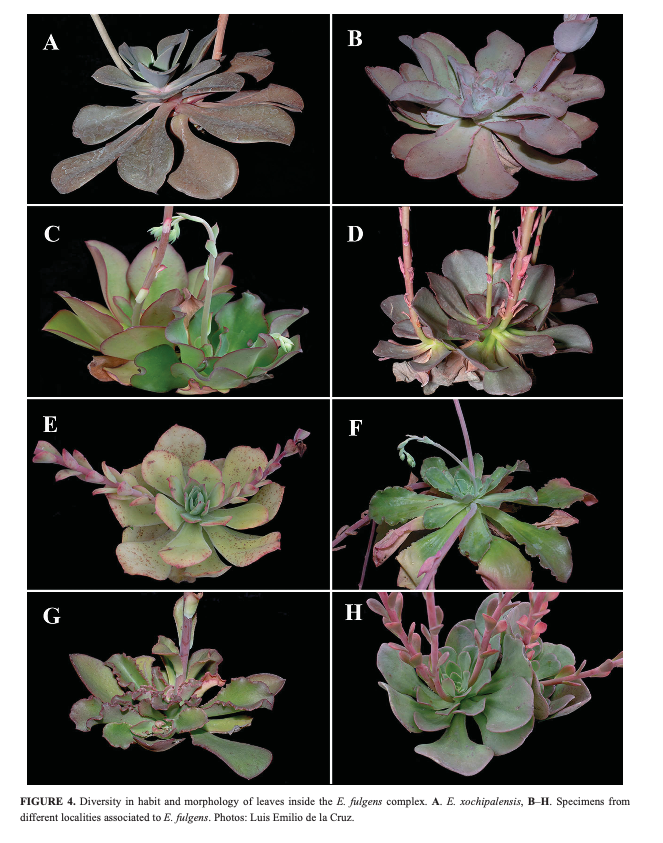
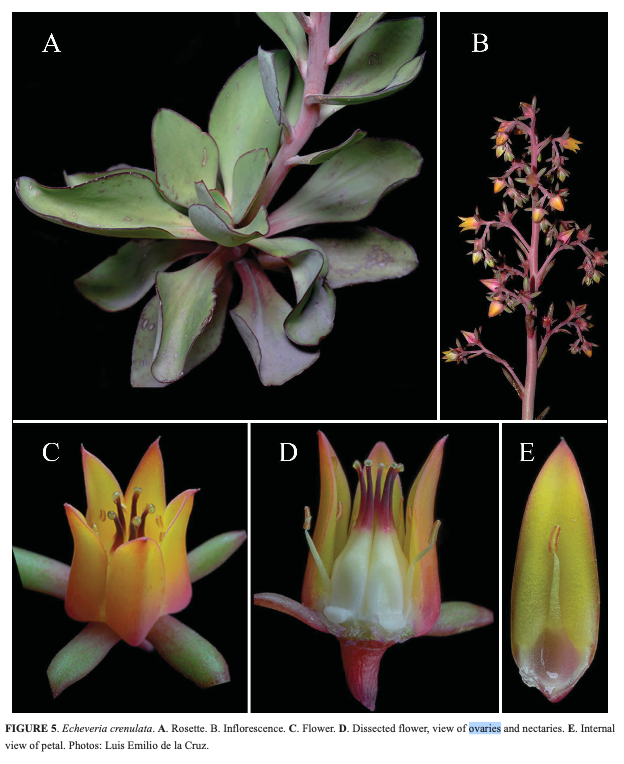
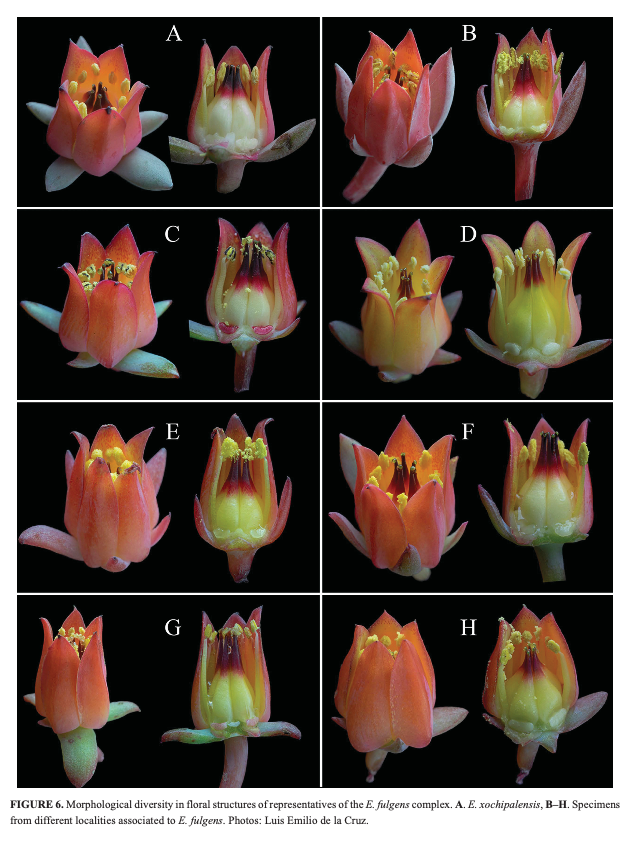
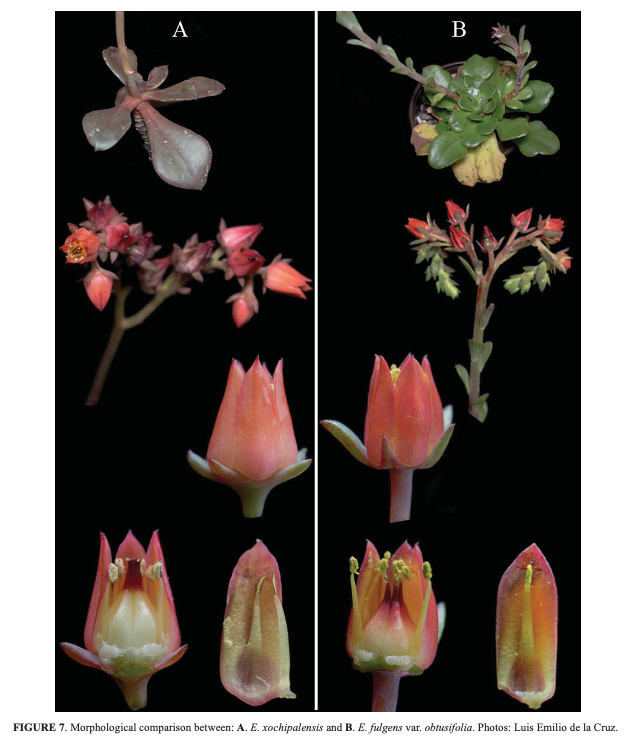
E. fulgens: MEXICO. Estado de México: municipality Amanalco, volcanic rocks 1 km south of San Juan
Amanalco, 2340 m, Quercus scrub, 8 December 1995, A. García-Mendoza et al. 6123 (MEXU); Michoacán:
municipality Ciudad Hidalgo, km 232 between Cd. Hidalgo and Mil Cumbres, old México-Nogales highway, 15 December 1965, C. Delgadillo 12 (MEXU); municipality Pátzcuaro, 2 km southeast of Cerro del Estribo, oak forest, 2230 m, 8 December 1986, J. Espinosa 2436 (MEXU); municipality Uruapan, malpaís (lava fields) of Capacúaro, forest of Quercus, 2250 m, 9 December 1996, E. Pérez-Calix 3544 (MEXU); municipality Zacapu, El Pinal, near Santa Gertrudis, 2100 m, oak forest on basaltic lava stream, 6 November 1987, H. Díaz y A. Grimaldo 4498 (MEXU); west of Angostura, matorral pedregoso, 18 November 1988, A. Grimaldo 422 (MEXU); municipality Zitácuaro, 3.78 km north of San Felipe de Los Alzati, pine-oak forest, 2147 m, 19°31´20.1”N, 100°21´59.7”W, 17 November 2014, D. Álvarez et al. 14683 (MEXU).
E. fulgens var. obtusifolia: MEXICO. Morelos. municipality Huitzilac, ± 1 km southwest of Huitzilac, on volcanic rocks, 2550 m, pine-oak forest, 25 October 1999, E. Pérez-Calix & I. García 3966 (MEXU).
Acknowledgments
The authors thank to CONACyT for financial support during projects 247078, “Iniciativa interdisciplinaria para el aprovechamiento sustentable del género Echeveria (Crassulaceae), plantas con potencial hortícola para la producción en áreas rurales de México” awarded to F. V.-S., and 232746, awarded to Laboratorio de Biodiversidad. We also thank DGAPA-PAPIIT, UNAM, for financial support of project IN212015, “Taxonomía integrativa y códigos de barras genéticos en Echeveria (Crassulaceae)”, awarded to F. V.-S. L. E. de la Cruz acknowledges the Posgrado en Ciencias Biológicas, UNAM, and CONACyT for graduate scholarships. Finally, we thank Julia Etter and Martin Kristen for advice on the English translation.
References
Bentham, G. (1844) Notes on Mimoseae. London Journal of Botany 3: 83–84.
Berger, A. (1930) Crassulaceae. In: Engler, A. & Prantl, K. (Eds.) Die natürlichen Pflanzenfamilien, ed. 2, 18a. W. Engelmann, Leipzig, pp. 352–483.
Candolle, A.P. (1828) Crassulaceae. In: A.P. de Candolle, A.P. & de Candolle, A.L.P.P. (Eds.) Prodromus Systematis Naturalis Regni Vegetabilis 3. Treuttel & Würtz, Paris, pp. 382–414.
García-Ruiz, I. (2011) Nueva especie de Echeveria (Crassulaceae) del centro-occidente de Michoacán, México. Revista Mexicana de Biodiversidad 82: 63–67.
García-Ruiz, I., Torres, I. & Costea, M. (2016) A New Species of Echeveria (Crassulaceae) from Michoacán, Mexico. Systematic Botany 41: 966–970.
https://doi.org/10.1600/036364416X694071
Jimeno-Sevilla, H.D. & Carrillo-Reyes, P. (2010) Echeveria perezcalixii (Crassulaceae), una especie nueva del occidente de México.
Brittonia 62: 303–308.
https://doi.org/10.1007/s12228-010-9137-1
Kimnach, M. (2003) Echeveria. In: Eggli, U. (Ed.) Illustrated Handbook of Succulent Plants: Crassulaceae. Springer-Verlag. Berlin, pp.
103–128.
Lemaire, A.C. (1845) Echeveria fulgens: Crassulacées & Obilicees. Hortus Vanhoutteanus 1: 8.
Meyrán, J. & López, L. (2003) Las crasuláceas de México. Sociedad Mexicana de Cactología, A.C., Ciudad de México, 234 pp.
Moran, R. (1974) Echeveria. In: Jacobsen, H. (Ed.) Lexicon of Succulent Plants. Blandford Press, pp. 184–186.
Née, L. (1801) Quercus magnoliaefolia. Anales de Ciencias Naturales 3: 268.
Nieves-Hernández, G., Vázquez-García, J.A., Muñiz-Castro, M.A. & Cházaro-Basáñez, M. (2014) Echeveria cerrograndensis
(Crassulaceae) a new species from eastern calcareous Sierra de Manantlán, Colima, México. Phytotaxa 172: 247–255.
https://doi.org/10.11646/phytotaxa.172.3.5
Pilbeam, J. (2008) The genus Echeveria. The British Cactus & Succulent Society. Essex, UK, 333 pp.
Reyes, S.J. & González-Zorzano, O. (2010) Echeveria roseiflora (Crassulaceae) una nueva especie para el estado de Jalisco, México.
Cactáceas y Suculentas Mexicanas 55: 19–26.
Reyes, S.J., Gónzalez-Zorzano, O. & Brachet, I.C. (2011) Echeveria aurantiaca (Crassulaceae), una nueva especie del estado de Guerrero,
México. Cactáceas y Suculentas Mexicanas 56: 68–74.
Roemer, J.J & Schultes, J.A. (1819) Ipomea murucoides. Systema Vegetabilium 4: 248.
Schlechtendal, D.F.L. (1838) Juniperus flaccida. Linnaea 12: 495.
Vázquez-García, J.A., Nieves-Hernández, G., Padilla-Lepe, J., Nuño-Rubio, A.T. & Cházaro-Basáñez, M. (2014) Echeveria munizii
(Crassulaceae) a new species of epiphyte from tropical Volcán de Colima, México. Phytotaxa 191: 165–171.
https://doi.org/10.11646/phytotaxa.191.1.11
Walther, E. (1972) Echeveria. California Academy of Sciences. San Francisco, 426 pp.
